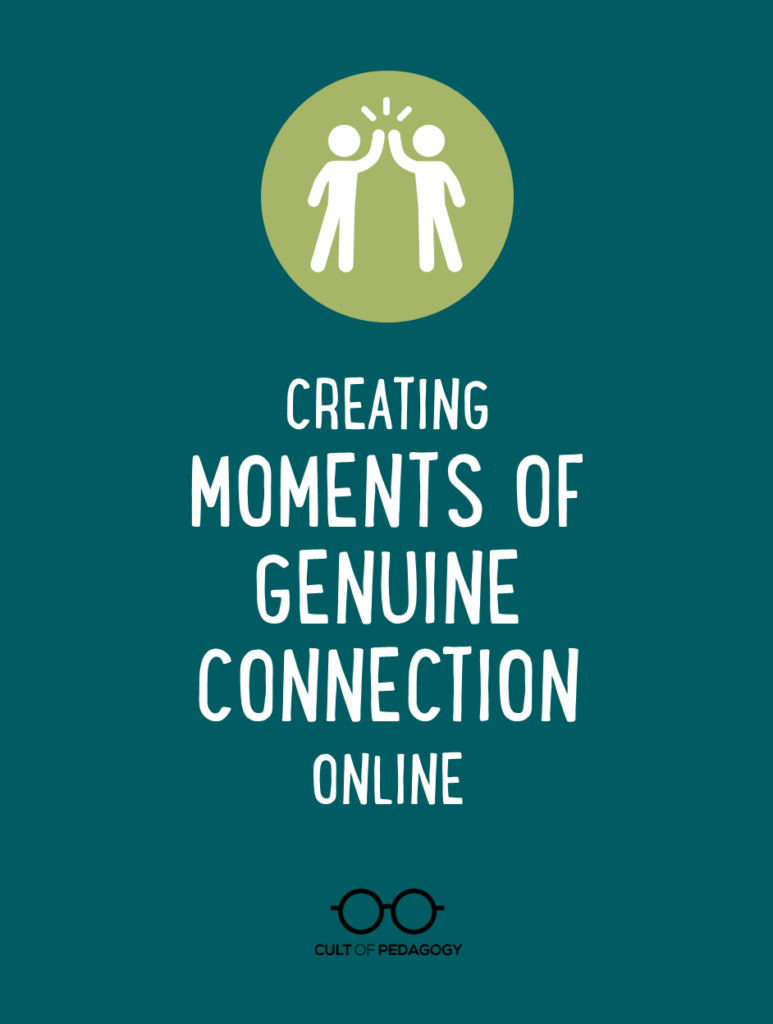
Listen to my interview with Dave Stuart Jr. (transcript):
Sponsored by Pear Deck and UL Xplorlabs
If you’re reading this in August of 2020, you’re most likely in the midst of juggling a hundred different things right now. You’re managing all the messy details of starting a new school year under constantly changing circumstances. You’re scrambling for resources. You’re debating the pros and cons of various reopening scenarios. You’re wondering how any of this can possibly be accomplished, and deep inside you’re pretty sure it can’t.
As all of this swirls around us, it can help if we stop, get very quiet, and focus on one thing, arguably the most important thing we need to accomplish as we move forward into the school year: building relationships with our students. While this goal is important during any school year, in 2020 it’s crucial. This virus has robbed us all of the human connections that help us to grow, support us through hard times, and make life on this planet so rich. For students whose home lives are not always safe, lockdowns have introduced trauma that regular school attendance may have prevented. We’re all still hurting. And we’re still not out of the woods.
If you’re one of many teachers who will be starting the school year online, or if you end up returning to online instruction at some point during the year, making those connections will be more challenging than in a face-to-face classroom.
To help you navigate this change, I invited Dave Stuart Jr. to share one of his most effective strategies for connecting with students. Stuart is a high school English teacher who helps teachers do their work better through his website, books, and online courses for teachers on student motivation, time management, and classroom management. His newest offering is a free mini-course, 10 Tips for Staying Motivated When Teaching in Times of Uncertainty. You can find all of his courses at cultofpedagogy.com/dave. (I am an affiliate for all of Stuart’s courses, so if you enroll in any of his paid courses through my link, I receive a small commission.)

I have been a fan of Stuart’s work for years now. Not only is he a really likable guy, but he goes pretty deep with his work, making sure he understands the research behind the principles he encourages in the classroom.
We’re going to focus on one specific strategy Stuart uses for building relationships with his students. He calls it making Moments of Genuine Connection (MGCs), which are just one small part of his overall approach to building trust in his classroom. First we’ll look at the strategy in general, and then we’ll explore some ways to make these moments happen in remote teaching situations.
What are Moments of Genuine Connection?
Stuart developed this approach out of necessity. He knew how important relationship building was, but the time it took to do it well was overwhelming.
“The first three years of my career,” he says, “I would spend 10, 15 hours per week solely focused on building relationships with students…before school, after school, during lunch. Massive amounts of time, time that I could not invest into feedback on student work or planning lessons.”
Needing a more efficient approach, he started experimenting with shorter interactions, limiting them to just 1 to 3 minutes, and tried to see how many students he could realistically and genuinely connect with in a day. It ended up working really well, allowing him to make many more students “feel valued, known, respected, and safe.”
Now, years later, Stuart has established clearer protocols for MGCs. To work best, your MGCs should fit these criteria:
- MOMENTS. In other words, brief. No more than 3 minutes each.
- GENUINE. You have to mean what you say. “We as teachers work hard in our hearts to actually want to connect with our students, to actually like them,” Stuart says. “Not every personality fits nicely with every other personality. MGCs call upon the teacher to do some inside work, some self-examination when negative feelings crop up with students.”
- CONNECTION. “What you’re after in these encounters is that set of feelings: valued, known, respected,” Stuart says. “So we call out specific things that we notice about the child, specific things that we know about them from information that they’ve given us.”
- EMBEDDED, NOT EXTRA. The moments are embedded inside the work you’re already doing as a teacher. “So they’re before class, right after class, during independent work.”
- TRACKED. Stuart keeps track of the MGCs using a class roster on a clipboard—jotting a few brief notes about the encounter—and doesn’t allow himself to start a fresh sheet until he has attempted an MGC with each student. Notice the word attempted: Stuart doesn’t insist on a successful connection every time and knows they may sometimes be awkward; he just holds himself accountable for trying. “We can’t control the emotions of a child,” he says. “We can just try to influence them in a direction that’s going to help them and us.”
- PERSONAL AND ACADEMIC. Attempt connections about both personal and academic topics.
Ways to Create MGCs Online
Waiting Rooms
Zoom offers a feature called Waiting Rooms, which allow a moderator to hold all participants in one space and only admit them into the conference one at a time. If you conduct synchronous class meetings, you can use this feature to have quick chats with a few students as they enter the larger space (this may work especially well with those who arrive early) or use the private chat feature to welcome them and add an MGC while you’re at it.
If you’re using another videoconferencing tool, look for a feature similar to this or brainstorm with your colleagues how you might creatively make something like this happen within your current platform.
Brief Office Hours
Consider requiring students to attend office hours via videoconferencing a few times per semester. If you schedule students in small batches, maybe alphabetically by last name, you can meet with each student for just a few minutes at a time and make those meaningful connections that way.
Embedded in Feedback
When you give students feedback on their work, many digital tools will allow you to attach audio or video clips to that feedback, and audio feedback in particular has been found to have a much more powerful impact on student work than its written equivalent.
So instead of setting aside extra time for an MGC, just add it on to the feedback you’re already giving to students. “Give audio feedback on student work,” Stuart says, “and go ahead and tag at the front or the back of that, Hey, I really appreciate the growth that I’m seeing in your writing, and I’ve noticed it.“
Personal Videos
Stuart picked up this idea from community college instructors who have years of online teaching under their belts. It’s built on the idea of “video postcards” teachers send to all students at once. “It’s you in a place outside of school, going about your life where you just say, Hey, I’m thinking about all of you guys.”
These videos could be done occasionally for individual students. Although Stuart admits this would be more work than other methods, it may be worth the effort every once in a while, and creative, tech-savvy teachers may be able to find ways to make it more efficient.
Phone Calls
For students who do not have reliable internet connections, or with whom other attempts have not been successful, your best bet may be to pick up the phone and call.
“They don’t need to be long at all,” Stuart says. “They can simply be a Hey, I’m checking in. Is anything getting in the way of your learning right now? And then, I just want you to know that I was thinking about this thing that we talked about previously. Or, I think you’re really going to like what’s coming up due to the interests that you shared on your survey.”
If you’re struggling to wrap your head around the upcoming school year, check out Dave’s free mini-course, 10 Tips for Staying Motivated When Teaching in Times of Uncertainty. You can learn more about all of Dave’s online courses at cultofpedagogy.com/dave (affiliate link).
Join our mailing list and get weekly tips, tools, and inspiration that will make your teaching more effective and fun. You’ll get access to our members-only library of free downloads, including 20 Ways to Cut Your Grading Time in Half, the e-booklet that has helped thousands of teachers save time on grading. Over 50,000 teachers have already joined—come on in.





What a great use of waiting rooms! I will definitely try this with my fifth graders. Also going to try to invite a couple of kids to “meet me for lunch” on Zoom each day so I can get to know them outside of class. Thanks for the post.
Great ideas! love the use of waiting rooms
I loved this episode! Do you happen to know more about the research that you referenced about students going through the day without adult interaction?
Hi Rich! Unfortunately, no–Jenn doesn’t think she actually ever saw the study herself. If she remembers correctly, it was something that one of her principals mentioned when they started to use advisory periods, so she’s pretty sure the study would be at least 15 years old. I’m sorry we can’t help out on this one!
For sure, it’s going to be challenging to make connections online, but through collaboration, support, and giving positive feedback, teachers will embrace a new way of teaching, and impact the lives of students in a new way of learning, during this age of Covid-19.
The spreadsheet tracker is a great way to make sure you have these moments with teachers. The “meet me for lunch” is a great catch-all for those who I missed.
Another thing that I think really helped was that I used good ole snail mail and would send out post cards to kids just to say hi and give them something fun in the mail. I usually would do a little funny artwork on the front or find postcards that are doodles the kids could color in. It felt like a small way to connect beyond the computer.
Love some of the ideas. Thanks.
I loved the section where it talks about co-teaching and how to make it work.
He had some great ideas – leaving audio messages for student with feedback of their work or even leaving audio messages just to say hi, – “how are you doing” etc. to let them know you care and know their there
Keeping it short is important in the busy life of students but by making it relevant to the students beliefs.
I really got inspired by this podcast to track when I connect with students, and what we’ve connected about. I was wondering if anyone has a template that they can recommend for that information?
These strategies for online learning are great ideas and can really make a difference in students’ lives. As a student teacher, everything that I have been learning focuses on the importance and priority of building relationships with students. During this time of COVID, it becomes even more important. So many students are struggling with both virtual learning and their home lives. Teachers need to be that relief and safety net for their students. These simple check-ins and connections can really help strengthen relationships, build trust and support, and ease students’ stress and emotions!
Thanks for the ideas! What are your suggestions for how to send video postcards or provide audio feedback? How would I integrate that into Canvas for example? Do you use Flipgrid for the postcards?
Hi Mary!
Any site or application that would allow you to record a short video message could be used for a video postcard. Flipgrid is a great resource which can be integrated into Canvas, and there are other applications that also allow you to embed a voice-over and/or record audio. You may want to check out Kaizena or Vocaroo as two simple ways to give audio feedback.
Hi Dave, many thanks for this excellent resource. When you keep a record of MGC what evidence do you include? I love that you do not move on until you have an MGC for all students – sometimes our natural biases mean we may have better connections with some students more than others. Kindest regards, Helen
Offering tips such as waiting rooms, phone calls, personal videos and office hours are simplistic yet effective methods to reach our students. This blog is refreshing because rather than identifying the problem, you identified solutions.
Good to know that the post resonated with you, Matthew! Jenn will be glad to hear it.
Hi l love your episode. Nice one. Send me updates of your podcast
Hi Stanley, you can sign up for the Cult of Pedagogy mailing list here to get an email every time a new post is published!